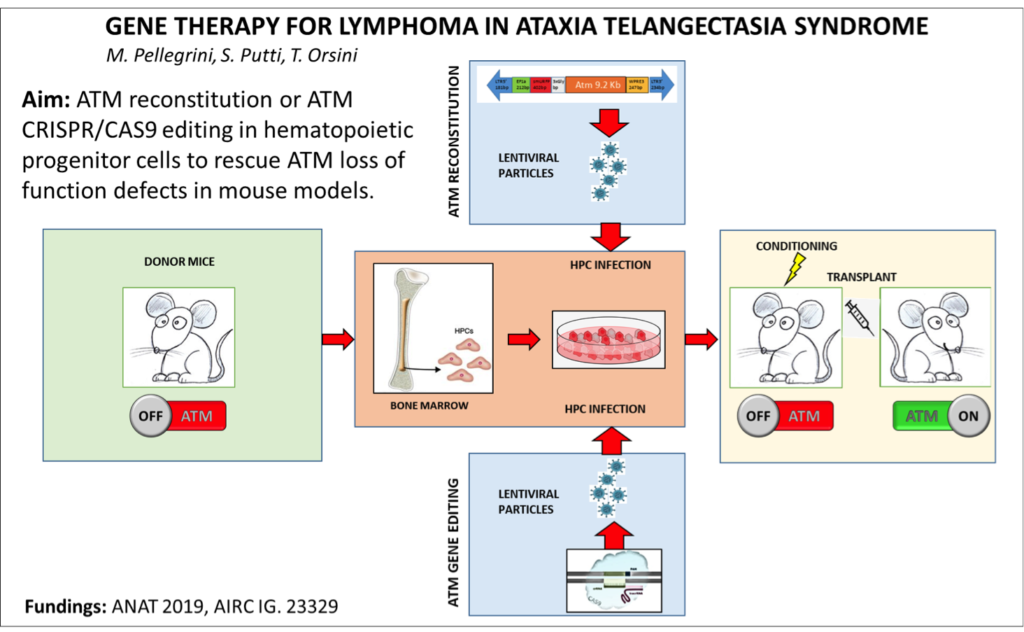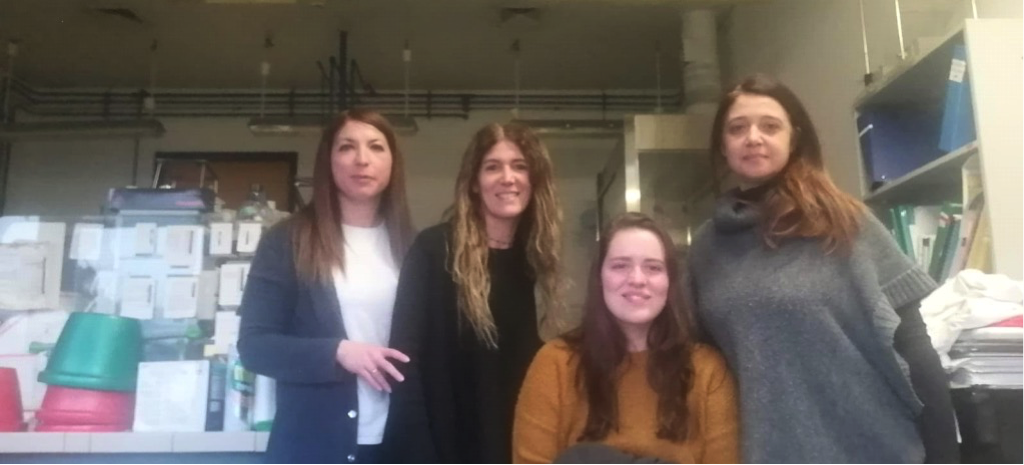Group Leader : Manuela Pellegrini
Topic: Molecular oncology and pathology
Key words: Genomic/Genetic instability; ATM Gene therapy; Animal models;
Genomic instability is a key event of cancer. To preserve genomic stability cells have developped systems to detect and repair DNA double strand breaks (DSBs).DSBs occur in response to exogenous agents, such as chemoterpeutics and during physiological processes as during normal DNA replication, meiotic recombination and lymphocytes maturation. If DSBs are not promptly repaired can be substrates for aberrant chromosomal translocations, which promote cancer.The focus of our research is to restore the function of ATM (Ataxia Telangiectasia Mutated) kinase that through an elaborate signal transduction system, has been established as a central player in DNA DSBs repair and genomic integrity preservation.
Ataxia Telangiectasia (A-T) is an inherited disease caused by a fault in the ATM gene that ultimately leads to death before the forties. The disease affects several body systems and causes neurodegeneration, immunodeficiency, sterility, radiosensitivity, lymphomas and leukemia predisposition. Moreover, missense mutations in ATM kinase domain are also found in many type of cancers, such as leukemia, lymphomas, breast, pancreas and gastric cancers but their impact on ATM function and implications for cancer therapy are largely unknown.
We aim to insert a correct version of ATM gene by lentiviral transduction and to edit ATM point mutations by the CRISPR/CAS9 strategy in human A-T cell lines and hematopoietic progenitor cells of ATM defective mouse models. Re-establishing ATM expression, we expect the rescue of immunological defects and the delay/prevention of thymoma in ATM deficient mice. Moreover, we expect to understand the specific role of ATM kinase activity and its essential targets indispensable for genomic stability maintenance.

Key Pubblications
Tassinari V, De Gennaro V, La Sala G, Marazziti D, Bolasco G, Aguanno S, De Angelis L, Naro F, Pellegrini M. Atrophy, oxidative switching and ultrastructural defects in skeletal muscle of Ataxia Telangiectasia mouse model. J Cell Sci. 2019 Feb 11. pii: jcs.223008.
Di Siena S, Campolo F, Gimmelli R, Di Pietro C, Marazziti D, Dolci S, Lenzi A, Nussenzweig A, Pellegrini M. Atm reactivation reverses ataxia telangiectasia phenotypes in vivo. Cell Death Dis. 2018 Feb 22;9(3):314.
Daniel JA, Pellegrini M, Lee BS, Guo Z, Filsuf D, Belkina NV, You Z, Paull TT, Sleckman BP, Feigenbaum L, Nussenzweig A. Loss of ATM kinase activity leads to embryonic lethality in mice.J Cell Biol. 2012 Aug 6;198(3):295-304.
Callén E, Jankovic M, Difilippantonio S, Daniel JA, Chen HT, Celeste A, Pellegrini M, McBride K, Wangsa D, Bredemeyer AL, Sleckman BP, Ried T, Nussenzweig M and Nussenzweig A. ATM prevents the persistence and propagation of chromosome breaks in lymphocytes.
Cell. 2007 Jul 13;130(1):63-75. IF 31.15
Pellegrini M, Celeste A, Difilippantonio S, Guo R, Wang W, Feigenbaum L and Nussenzweig A. Autophosphorylation at serine 1987 is dispensable for murine Atm activation in vivo. Nature. 2006 Sep 14;443(7108):222-5.
Research group

Researchers:
- Sabrina Putti
06-90091-333 | sabrina.putti@cnr.it - Tiziana Orsini
06-90091-334 | tiziana.orsini@cnr.it
PhD student
- Bruna Sabino Pinho de Oliveira
Programs & resources
2019 ANAT (PI). Title: Gene therapy for Ataxia Telangiectasia syndrome. https://www.associazione-at.it/associazione-nazionale-at/
2019 IG grant of AIRC, Project Code: 23329 (PI). Title: Gene therapy for Ataxia Telangiectasia syndrome and for cancer-associated ATM kinase mutations. https://www.airc.it/
2012 PRIN MIUR, Project code: 2012227FLF (Unit). Title: MUSKENDO https://prin.miur.it
2009 MFG grant of AIRC, Project code: 8904 (PI). Title: Relationship between DNA damage and signalling revealed in mouse model of Ataxia Telangiectasia. https://www.airc.it/
